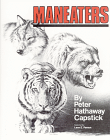| Experts
are rethinking advice on near-bear experiences
Sunday, October 01, 2000 By DRU SEFTON When the grizzly charged, Patricia Van Tighem did what hikers have always been told to do. First, she scampered up a tree. The bear batted her down. Then she lay still on the ground, playing dead. The bear began gnawing on her face, ripping skin and muscle from her skull. Van Tighem finally did something she wasnít supposed to do: She reached up and poked the bear in the nose. The bear retreated. "Staying still didnít work," said Van Tighem, whose new book, "The Bearís Embrace," details the grueling 20-year physical and mental aftermath of the attack on her and her husband. "If I kept playing dead, I would have BEEN dead." The common advice always has been - and still is - that if youíre threatened by a grizzly, play dead; if youíre threatened by a black bear, fight back. But a summer of attacks involving not only fierce grizzlies but also normally docile black bears has some experts questioning those approaches. The issue becomes more important as bear populations increase and human-bear conflicts, the term that researchers use for these sometimes violent interactions, become less rare. In late May, a black bear preyed upon hiker Glenda Ann Bradley about 10 miles outside Gatlinburg, Tenn. It was the first recorded black bear fatality in the history of the Great Smoky Mountains National Park. Then, early in July, Canadian biathlete Mary Beth Miller was killed by a black bear outside Quebec City. After that, human-bear conflicts made news all summer: Black bears clawed or bit four Boy Scouts in July at the Philmont Scout Ranch in northeastern New Mexico. In August, two backpackers were charged by a bear of undetermined species in Glacier National Park in Montana. One was bitten on the thighs and hips. Also in August, a Calgary, Alberta, a man was mauled by a grizzly in the Kananaskis Country of Canadaís Rockies. It was the second incident in 12 hours; those were the first attacks there in 22 years. In September, attacks have been reported in Clam Falls, Wis.; Hoonah, Alaska; Grand Junction, Colo.; Anchorage; McLeod Lake, British Columbia; and Yellowstone National Park. "Conflict is increasing all over," said Gary Shelton, who has studied bears for 35 years and written two books considered to be the seminal works on bear aggression. "Whatís happening is bear attacks are taking place where they havenít before, thereís a higher level of fatalities, and there are more deadly attacks by black bears." Protecting people and their property from bears is a politically sensitive issue. "Bears have become an icon that represent all things bad mankind has done to nature," Shelton said. New Jersey recently canceled a black-bear hunt after public protest. In the last year officials there have documented 25 bear attacks on livestock and 40 on household pets. Shelton, who lives in the remote Bella Coola Valley of British Columbia, began his career as a conservationist. He came to think that bears were becoming "overprotected" - that populations were growing too large - so he "shifted gears" to study what people can do to avoid or minimize bear attacks. According to the North American Bear Society, nearly 800,000 black bears roam across Canada and all but seven American states. Grizzly numbers are harder to track, as the bears are more elusive. The U.S. Fish and Wildlife Service estimates that 1,200 grizzlies are spread throughout Montana, Idaho, Washington and Wyoming, and 30,000 live in Alaska. University of Calgary environmental scientist Stephen Herrero, a bear expert, estimates that 60,000 brown bears, the species that includes grizzlies, live throughout North America. Statistics on bear attacks are difficult to compile. Many happen in remote wilderness and go unreported. Herrero, author of "Bear Attacks: Their Causes and Avoidance," estimated that on average, bears kill three people and seriously injure between five and 15 annually in North America. "Overall the injury rates are very low considering the millions of interactions that occur each year," he added. But in August, Herrero told the Calgary Herald that the number of bear attacks this year is among the highest since biologists began keeping records 28 years ago. Specific numbers were unavailable. If people want to learn how to co-exist with bears, "it is incumbent upon us to figure out how they think," said Tom Smith, a research wildlife biologist with the U.S. Geological Survey in Alaska and an expert on bear-human interaction. Smith is studying grizzly bear responses to smells, sights and sounds associated with human outdoor activities. He travels through the wilderness displaying different colored tent materials and playing voice recordings, noting bear reactions. Avoidance remains the best defense, yet some people are naive about keeping bears at bay, Smith said. "Campers put papaya-guava-honey shampoo on their heads and then wonder why bears are paying attention to them," he said. "Come on, people, this is stupid." To a bear, thatís about as inviting as "bacon and egg shampoo" would smell to a hungry hiker, Smith noted. Much of Smithís research runs counter to accepted bear-avoidance tactics. He has discovered that pepper spray, a common deterrent, actually may attract bears if used incorrectly - that is, applied to tents, containers or clothing as opposed to sprayed directly at a bear. Smith also published a study on the use of "bear bells," which hikers hang from walking sticks, belts or backpacks on the theory that a noisy approach will keep them from catching a bear off guard. He hung a row of the noisy bells on a bush. Over time, 15 grizzly bears wandered past the bells as he rang them; the beasts "didnít even twitch an ear." "Some things that are taught as standard safety messages, I think, Why in the world do we do that?í " he said. Smith sees this summerís attacks as an aberration. "The overwhelming majority of bears have no desire to deal with people," he said. However, "there are those Jeffrey Dahmer and Ted Kaczynski bears," like the human murderers, that set out to kill. Shelton, meanwhile, is preparing a paper for the International Bear Association conference next May that details his theory: Black bears, in certain circumstances, will indeed prey on humans. "Thereís going to be a slow, steady increase of predatory black bear attacks that will catch bear managers off guard," he predicted. Shelton pointed out that because black bears and grizzlies evolved from a common ancestor, a "true predator," each species is capable of predatory attacks. So the common advice to fight a black bear but play dead for a grizzly may not hold true, particularly if the bear has targeted a human as prey. After conducting in-depth interviews with 40 survivors of attack by bears, both black and grizzly, Shelton now takes "a strong position against playing dead." "If the bear is deciding if youíre prey, and you play dead, thatís exactly what happens to you," he said. He devotes a chapter in his upcoming book to the topic. So what is the best way to protect yourself in bear country? Shelton said to carry pepper spray and use it correctly - shoot it directly at the bear, then leave the area immediately, as the bear will be temporarily stunned by the burning sensation. "Even though the spray success rate runs at about 75 percent, it is a far better strategy than the play dead/fight backí concept," Shelton said. ©2000 THE PLAIN DEALER. BACK to Animal Attack Files Index Tell a Friend about the Animal Attack Files |
||
| HOME
Books on BEARS: Bear
Attacks
Animal Underworld: Inside America's Black Market for Rare and Exotic Species Every Creeping Thing: True Tales of Faintly Repulsive Wildlife --- |












